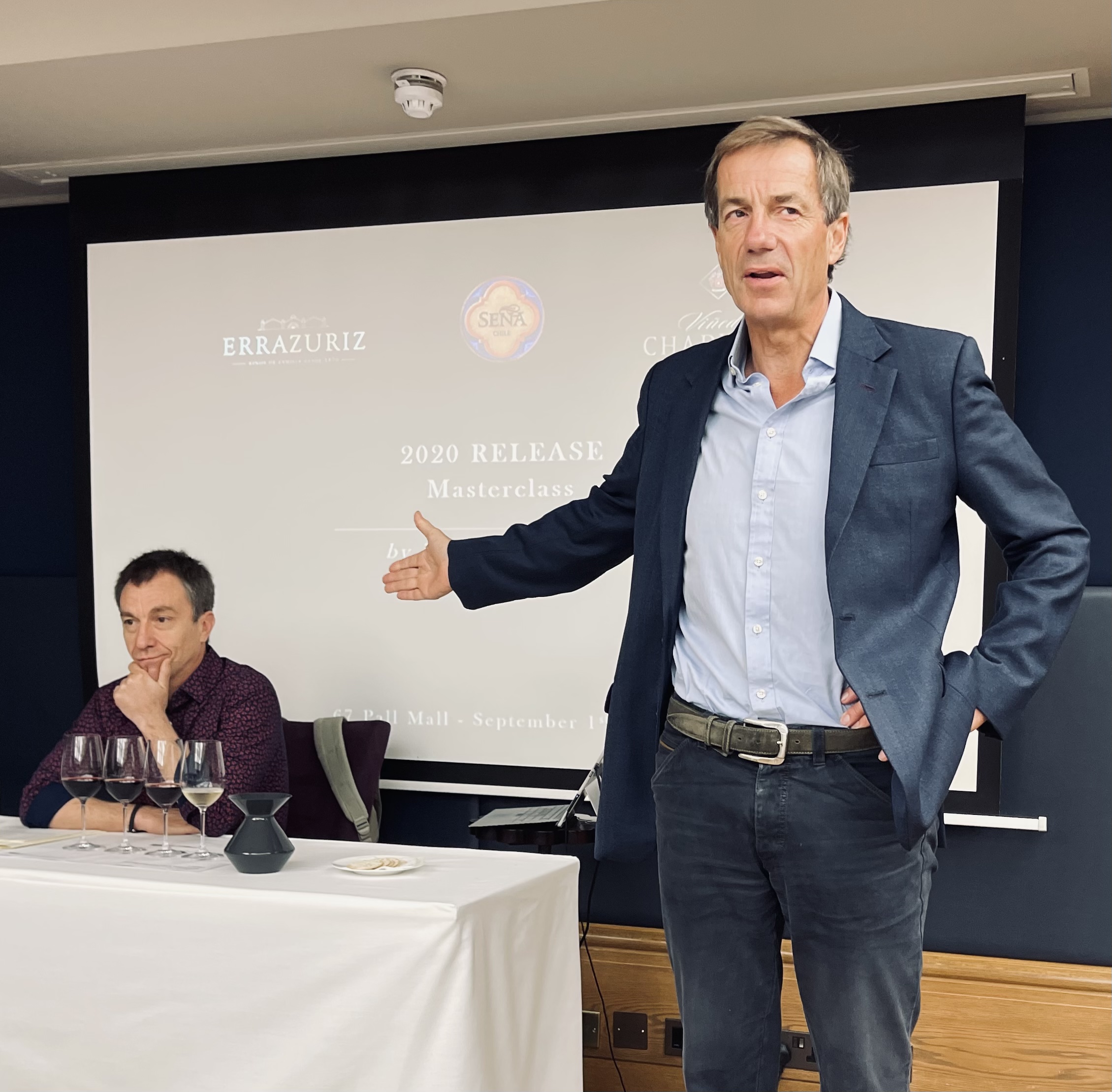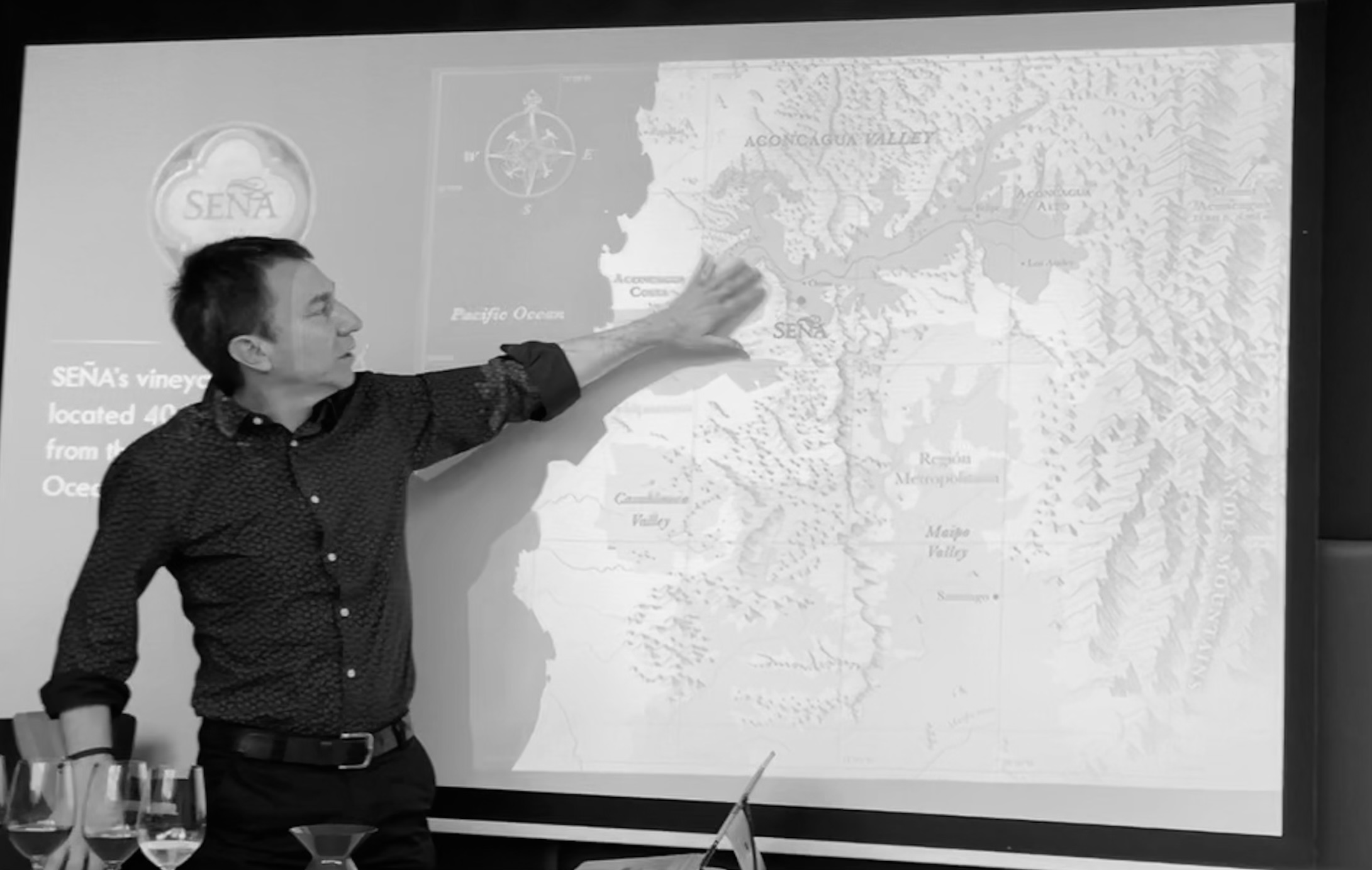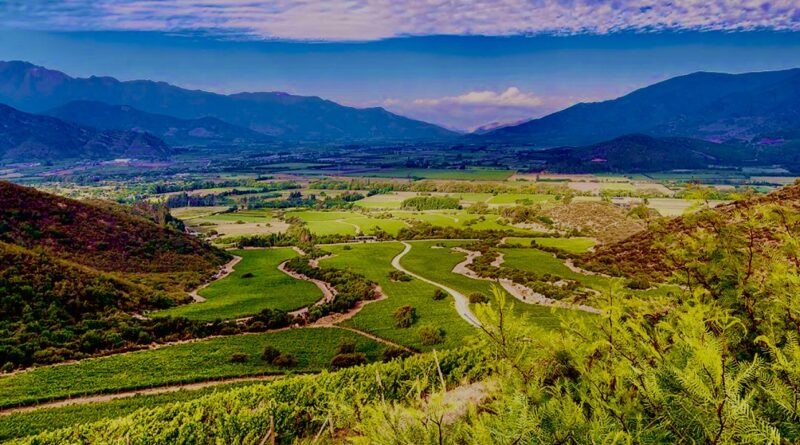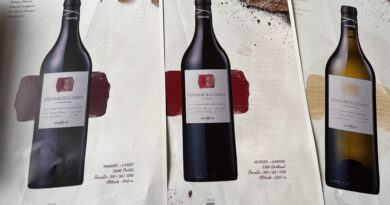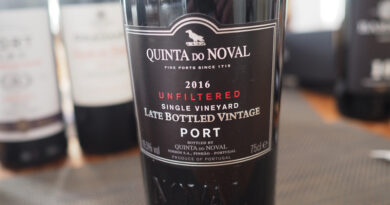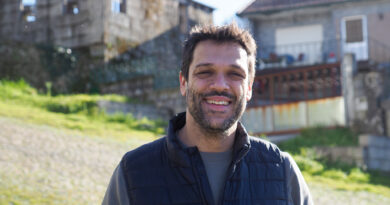As Chile votes no to a radical new constitution Francisco Baettig delivers yet another round of iconic bottles to the world’s collective table..
Chile is at a pivotal point in its history – Sunday saw an historical vote on a new Constitution that sought to transform the entire status quo overnight – water rights were a key issue – crucial to the vine.. Can this most stable of all latin democracies – the country the world likes to do business with, accomplish radical egalitarian change without a return to the protests of 2019? A mandate to draft a new constitution remains in force and a new draft seems likely.
In the first of three reports, Lisse Garnett paints a background picture as she prepares to visit Chile’s fascinating wine regions by tasting the new range from Viñedo Chadwick, Seña and Errazuriz with winemaker Francisco Baettig
Chile has voted against a new constitution, the culmination of a two-year plan to appease a partially rioting populous and foster a period of rapprochement and reconciliation. Anti-government demonstrations crippled Chile in 2019, a subsequent vote over the drafting of a new Constitution returned 80% in favour. It is hoped that a new Constitution will herald a new era of social progression and change and a second draft seems likely.
The bones of Chile’s much amended existing Constitution were drafted in the 80s under the rule of Augusto Pinochet. They are seen by many to represent a conservative right-wing ruling class. Here in the UK there is much talk of a widening divide between the haves and have nots – in Chile the gap is more tangible. Chile’s democracy had been rated as flawed by the Economist Intelligence Unit; in 2019 Chile’s rating rose 11 points to full democracy.
Ferocious demonstrations in 2019 laid bare the resentment a cavernous class divide has fostered. Dissatisfaction evidenced by the 2021 General Election result. New President Gabriel Boric is 36 – the youngest state leader in the world. He ran as the Presidential Candidate for Apruebo Dignidad, a left-wing conglomerate formed to unite the then opposition during the violent protests of 2019. Boric won 55.9% of the votes in the second round of the Presidential election with a turnout of 55.7% – the largest turnout since 2013 when voting became voluntary.
Chile was ruled by a military Junta from 1973-81 headed by Captain General Augusto Pinochet. He had risen through the army ranks before being appointed Commander in Chief by President Salvador Allende. On September 11, 1973, Pinochet seized power and toppled Allende’s democratically elected left-wing Unidad Popular government. He went on to persecute leftists, socialist and critics, imprisoning many thousands and murdering his opponents.
Pinochet implemented economic liberalisation on neoliberal lines, banning trade unions, removing tariff protections for industry and privatising hundreds of state-owned industries. Censorship was also employed. High economic growth was the result but the gap between rich and poor widened ever further.
In the 1990s Chile had the best performing economy in Latin America. Pinochet grew rich and was eventually prosecuted for embezzlement. In 1998 he was arrested in London on charges of genocide and terrorism. The first time a government head was placed under house arrest on the principle of universal jurisdiction. He was eventually released by tory Jack Straw on medical grounds and he did not stand trial. He returned to Chile and was given a heroes welcome. There were demonstrations against him but these were not televised. In March 2000 Chilean Congress approved a constitutional amendment creating an ‘ex-president’ status that rendered Pinochet immune from prosecution and provided a financial allowance.

Voting for or against the new Constitution is mandatory for all who are eligible to vote. Higher taxes on the wealthy, social justice and climate change were all key elements addressed in the first draft of the proposed Constitution. Critics call it fantastical; they say it attacks the free market liberal and social economic model that has made Chile so prosperous. The Constitution includes the right to abortion and demands women hold 50% of roles in public institutions. A state controlled social security system was to be created and access to water enshrined as a fundamental right. It also recognised Chile’s indigenous population’s right to land and resources.
Media reports recorded a mood of uncertainty and polls showed that more would vote against than for the bill in this traditionally Conservative Catholic country. Progressive’s may have won the Presidency but Congress remains fragmented – making for a divided government.
Transport, water and electricity are governed by private companies in Chile and water rights are in private ownership. This has been a bone of serious political contention. Chile’s indigenous Mapuche make up some 9% of her 19 million strong population. Having been marginalised for the past two centuries, they are demanding greater territorial rights, including rights to water. In May the government imposed a state of emergency in the South following the deaths of Mapuche activists, security forces and forest activists.
Though there are many ancient dry farmed vines in Chile, all depend on water. Production is broad – Chile creates high-priced world beating icon wines such as I taste in this report and expertly made workaday value wines too. There are also a growing number of mid-range alternative low intervention wines that are becoming ever more exciting – reflective of place and often wildly experimental – they represent Chile’s radical New Wave.
Water in Chile is a critical resource as it is throughout the world, crucial Andean meltwater forms the basis of many a vineyard’s route to supply and snowfalls have lessened progressively – though 2022 was better. Bore holes are a solution but they are wildly expensive to drill and not accessible to most.
Today Chile offers wines of undisputed greatness and undisputed value – there is also a New Wave of outré low intervention mid-priced wines very much indicative of place that are making a noise – especially in the States. They need to break through to European markets spoilt by cheap clean faultless low-priced bottles.
Chile has always been considered the safe place to do business in Latin America by the west. Often ridiculed by her neighbours and certainly totalitarian under Pinochet – Chile fashioned its own way to economic stability and succeeded. The ghastly crimes of the Pinochet dictatorship should not be airbrushed nor should the questions of equality but critics say the first constitution was not about forming a new united Chile but more about class war. Change is needed and it will come, that much is clear.
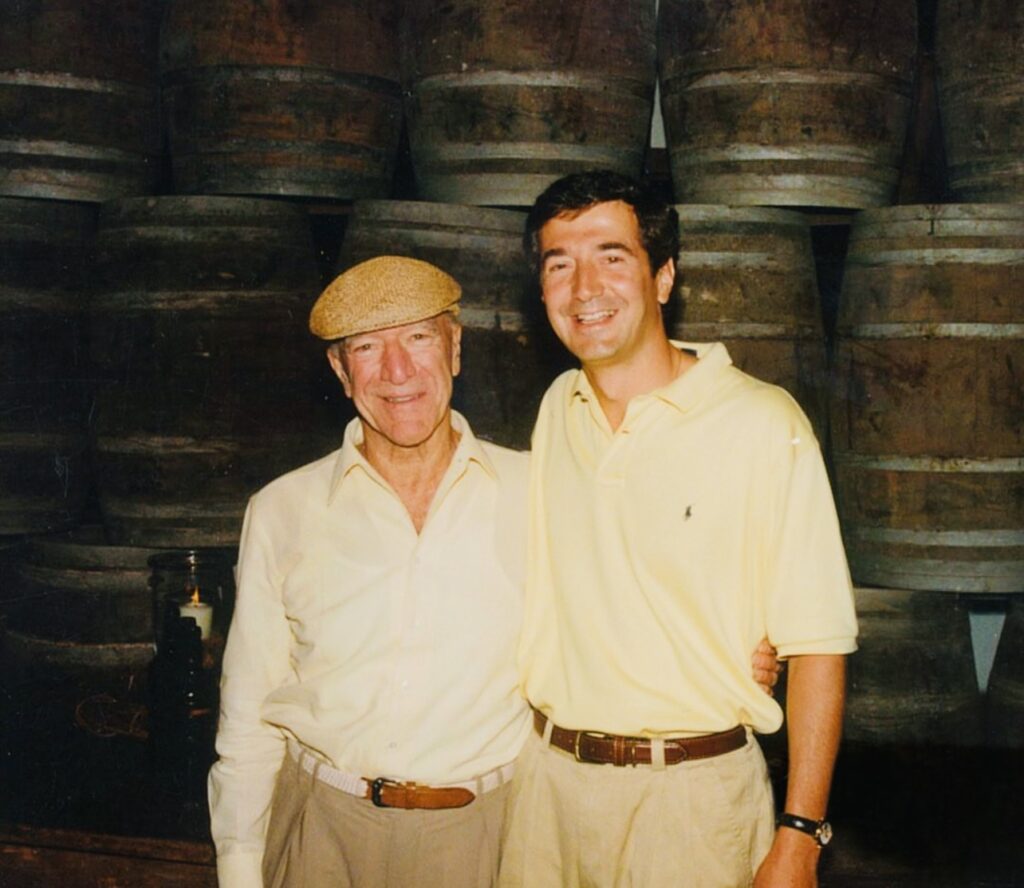
Errazuriz, Seña and Chadwick
The new releases of Seña and Chadwick Rocas de Seña were the principle reason for winemaker Francisco Baettig’s UK visit. Seña’s new second wine Rocas de Seña had sold out before we even had the chance to speak..
Such is the love for the wines of Francisco Baettig, a man of genuine humility who is softly spoken, open and direct, even when thrust into political territory by my questions for which I gave no warning.
All nations have their Asterix and Obelix style stereotypes – we English are emotionally thwarted hopeless drunken buffoons; Chileans are characterised as uptight and class conscious. This is absolutely not the case with Francisco who is unguarded and open – not at all fearful of discussion even as his country faces one of the most challenging periods in its history. In some ways his wines represent a new way – Chile, known for decades as the place for bulk production – came audaciously to the market with Seña buoyed by Mondavi’s savvy marketing – they priced themselves to sit with great icon wines and they succeeded.
The project began when a young Eduardo received a visit from sprightly Mondavi in 1991. Francisco jokes about their friendship which he says was formed as Eduardo Chadwick played chauffeur . Eduardo had been trying for a long time to make a world class wine, Mondavi was to prove the perfect partner. They created Seña and the first vintage was released in 1995. It became the first Chilean icon wine to be exported.
Seña was created to place Chile on the icon map, it opened the door. When it was launched it was considered racy at 20 dollars a bottle, this was vindicated when critics bestowed a 90-point score – then a milestone for Chile. From the beginning Mondavi and Chadwick had wanted to produce a Bordeaux blend with a Chilean touch – Carmenére.
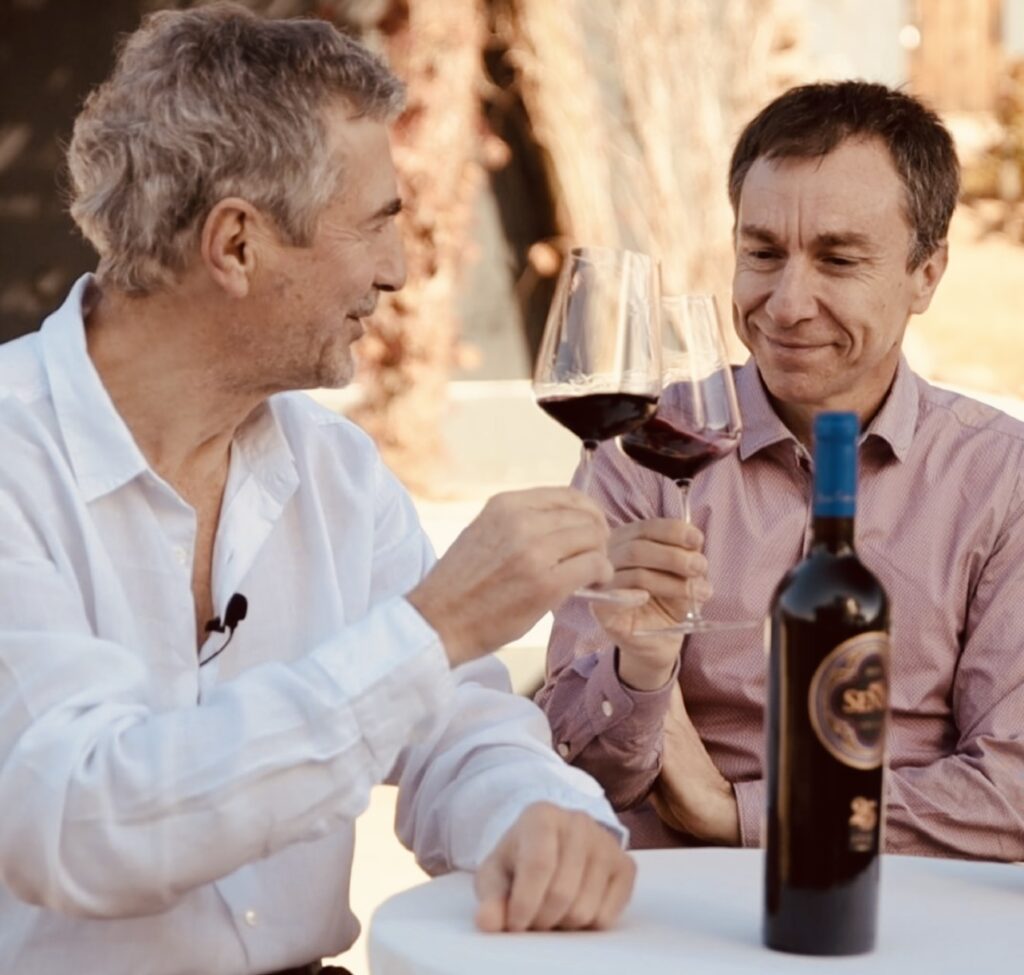
Baettig has been the winemaker at Errazuriz for some twenty years and is very much considered Chile’s vinous maestro. Pizarras is a project born of a vineyard in Aconcagua close to the ocean, planted in 2005 to produce Chardonnay, Pinot Noir and Sauvignon Blanc. At only 20 km from the Pacific the vineyard is quite cold. The soil is schist. It was this schist that diverted plantings toward Chardonnay and Pinot Noir with a view to creating two more icon wines from varieties they didn’t have. I asked Francisco to take us through the winemaking process for each of the wines we tasted.
Francisco Baettig: In the beginning Seña was made with Carmenére and quite a bit of Merlot, now we have way less Merlot because we had thought it was an easy variety but it’s not, it’s very demanding, it has a shallow root system and it doesn’t do that well in Chile so we’ve been replacing it with Malbec and petit Verdot and Carmenére. Since 2005 we became organic and biodynamic, we use sheep to keep down the grass. We are sustainable and we do not use herbicides.
Lisse Garnett: When did you notice the changes manifesting in the glass?
FB: Eduardo performs these tastings with the icon wines, he has been doing so for ten years – he wanted to show the ageing of the wines so showed old vintages.
We got 100 points with the 2015 vintage – a good result from the critics.
The good thing is that we are improving, that’s the main thing for me. In the past we were having a party if we got 91, now we are getting depressed if we get 95. So it shows that Chile is moving up in people’s perception and getting recognition, that’s good for us and the country as a whole.
LG: Take us through the changes at Seña.
Seña today makes up 42 hectares in total and is closer to the ocean than Errazuriz. As it’s situated in Aconcagua where the coastal mountain range is highest at 3000m, it would be too cold to ripen grapes if we’d planted to the west of the range. The cool breezes of the Pacific, cooled by the Humboldt current, follow the river and they influence the temperature in the vineyards. It is way cooler than inland and in general we pick one or two weeks later.
Some of the soils are alluvial from an ancient dried up river, there is also clay and volcanic rock. There is a lot of diversity within the property. We analysed the soil types and realised we’d made a few mistakes with varieties on terroirs. We reshaped and replanted and today we are maximising the place with the proper variety in the right place.
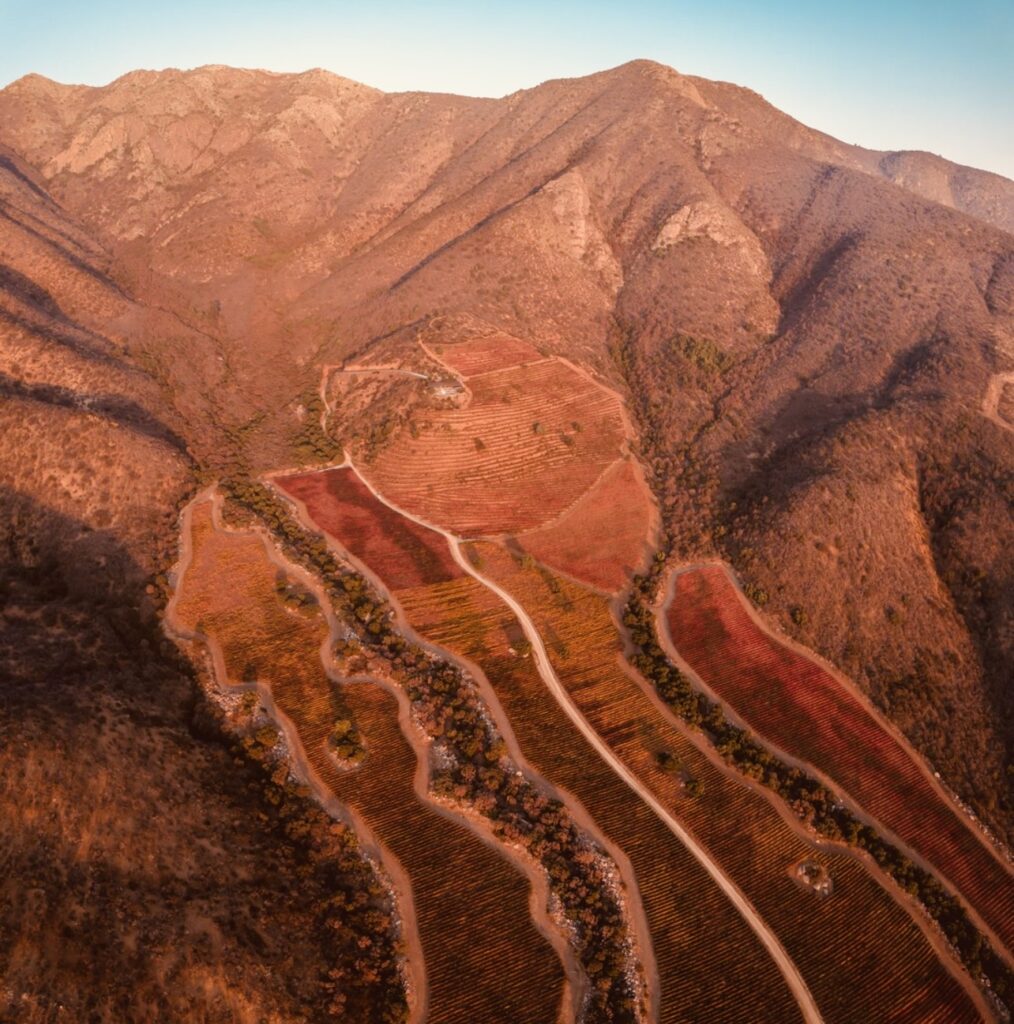
LG: What makes Rocas de Seña different?
In 2005 we chose not to go the traditional way, the Bordeaux way of selecting the best wines then blending. Instead we tried to identify the best terroir within the property and broaden the approach. We don’t have their appellation system but if we were to create a Grand Cru, that is what we would do.
We have 50 hectares of Chardonnay and 70 hectares of Pinot Noir. Its unusual to find metamorphic rock like slate in Chile, its usually more volcanic. It was a nice surprise. It gets direct influence from the cool winds of the Pacific and the Humboldt Current. Its very hilly with all kinds of exposure and half of it is facing South. We worked with a French Geologist to try and identify what could potentially be Grand Crus parcels. Today we have two parcels of Chardonnay and two of Pinot Noir. We are looking for more elegance and more mineral, complex wines. That is why we have made so little and production is so limited and small. It’s really about origin and terroir, a more Burgundian approach. In Chile we don’t have an appellation that exerts control but I try to control it!
LG: Has it worked?
We’ve had a lot of success, especially with the Chardonnay. Once you have that result then straight away you have the pressure to produce more. But we have been true to the origin, to the idea and so we continue to produce a very small amount.
The first vintage was 2014 so it’s not very old but I think it’s very important for Chile because it proves that we can produce high end Pinot and Chardonnay if it’s coming from the right place with, very importantly, the right plant material. We planted clones from Burgundy and the styling here is more restrained and a bit more austere – not exuberant and tropical like you might usually expect from Chile. We also manage the oak, its 100% barrel fermented but there is not that much new oak.
For the Chardonnay we don’t cold macerate or destem but whole cluster press, we get a very clean juice, no commercial yeast and a little bit of malolactic. 2020 was a warm vintage and dry so the main challenge was how to preserve the acidity and the tension in the wine and to manage the alcohol. It’s 12.5% because we harvested very early at the beginning of February. In Aconcagua the budbreak is very early – in August – unlike Casablanca, or further South. This is why we harvest in early February if it’s a hot vintage. The ripening days are the same but budbreak is sooner and hence so is harvest. In the beginning we didn’t know this, so we were harvesting in March so of course the alcohol was higher and the wines were riper and bigger. We’ve been fine tuning and refining the product. New oak is 30% here with big 400 litre barrels and I think for a hot vintage we have to be very cautious about the moment we harvest. We managed to preserve the style of Pizzaro’s which is a more tight, vertical linear wine.
With the Pinot we use a little bit of whole cluster, about 50% to give a freshness and a structure to the wine. I also use a little oak because the vines are not that old and they require more structure and concentration. 300l barrels are used and this lends tannin and structure to the wine.
LG: What has working with Pinot and Chardonnay taught you?
Overall in Chile the change in Pinot has been really interesting as we aim for more purity and fruit intensity, more freshness and typicity. In the past we were picking later so the wines would evolve faster with less acidity. I am changing and learning with the Pinot because it is a very challenging variety.
I like the tension and the freshness in the Chardonnay. It’s a linear wine but also on the nose there is a floral note, there is not that tropical character, its more restrained and subtle. We did about 40 percent malolactic this vintage. Usually with cooler vintages we get PHs of three which is quite good, quite low. That is why I wanted to harvest earlier, to retain the tension in the fruit. I think this is one of the lowest alcohol wines we have. If you compare with 17, there is less concentration but we managed to have the dry style with a good tension. We do a little bit of battonage but in the beginning, we don’t want the wine to become too creamy.
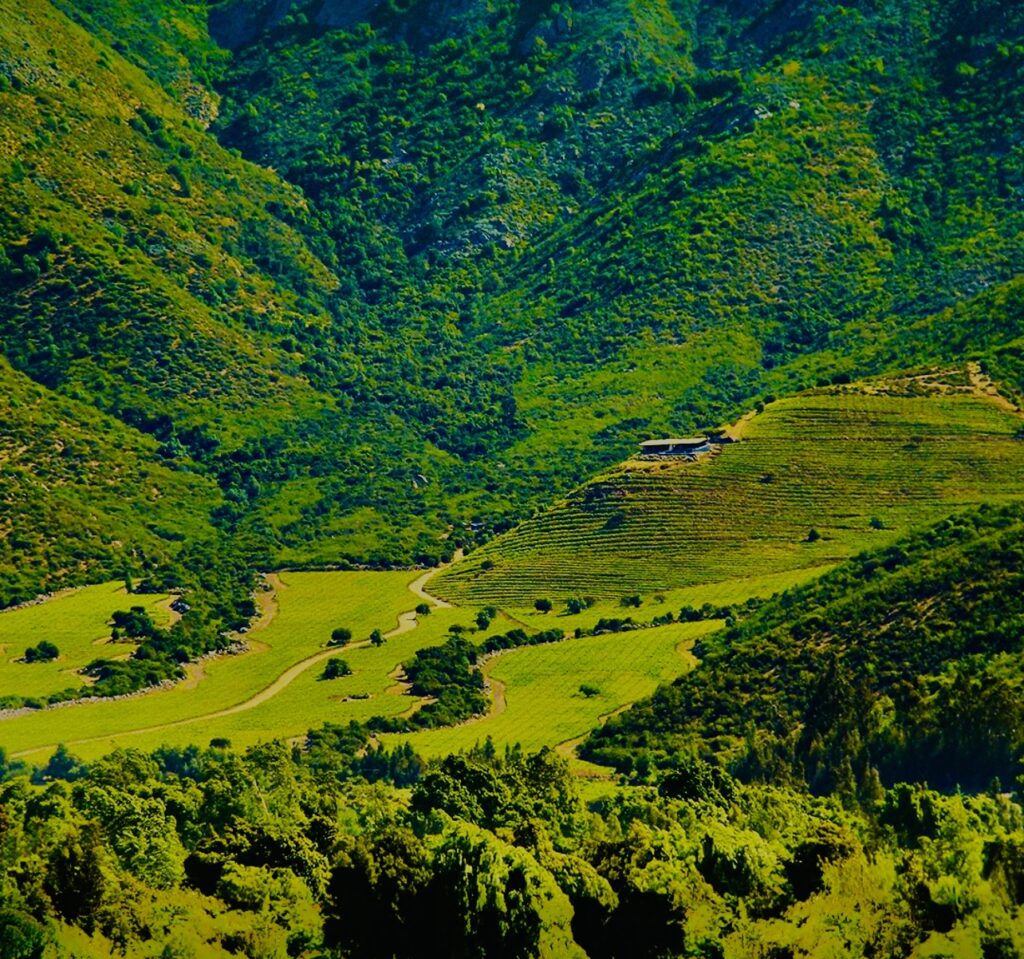
LG: How has the winemaking evolved?
In the case of the Pinot Noir – we have learned a lot about this variety – in the past in Chile we were more Bordeaux focused. We realised that we need to be very gentle – really it’s more like making tea than wine – more like a soft maceration than extraction. The whole approach is very different today, we try to push the malolactic fermentation as much as we can because once its finished we have to start adding SO2 and the SO2 is very detrimental towards the Pinot. We keep the temperatures very cool in the barrel room so the malolactic happens later in the Spring and we have managed to get the use of SO2 very low now. I think that makes a big change in the style and the purity of the wine. We take one month to add the SO2 once the Malo has finished, we don’t want to do it in one big hit but in small doses every two weeks over a number of weeks. We also irrigate more in the vineyard, we encourage a bit more vigour, we extract less and we harvest earlier. As a result the wines are more balanced with better colour and acidity.
In Aconcagua Costa the soils have more a lot of manganese and iron so usually you can find a bit of iodine and blood character in the Pinot not just pure fruit. Seventeen was a really hot vintage, similar to 2020, slighter warmer. The main difference was the tiny crop, the smallest production ever. It was very concentrated; we had to run and pick everything very fast.
In the 2020 the colour is quite nice, as is the intensity on the nose and there is some complexity in the glass. Some of the Pinot was a bit one dimensional with only fruit but here we have more layers and the vertical is nice with more structure. I like the texture, I think there is an earthiness, a chalkiness on the palate. We have been looking for that, not to have a really elegant Pinot Noir but to have a little more grip than we used to have in the past.
The vines are very young, do you notice this in the glass?
I found that since the vines were still a bit young and overall they lack structure or bones, and grip. So the production is quite slow so we can get more concentration, the whole bunch adds phenols and tannin and new oak lends some more structure to the wine, the challenge is not to overuse the whole cluster as we might get greenness or bitterness coming through – this is also true of oak which might overpower.
It’s a balance that we try to achieve but I think as the vineyard gets older we will naturally get more concentration in the wine.
How does the terroir manifest in the glass in your opinion?
The profile of Pizarras is in general – I do not know how to explain scientifically – but this is a style of wine that is more linear overall which I think is related to the soil, the metamorphic rock. It’s not limestone but the geology is very similar to Burgundy in the sense that in one part the rock is closer to the surface so you have more shallow soil and more elegance, less structure. Deeper soils provides more fruit and richness and in the middle there is the perfect balance. This fruit comes from a few parcels with a decent balance between soil and rock, this manifests in some balance, some elegance and structure in the wine.
We are still learning and trying to understand the property, the place give this texture to the wine, I like that chalky earthy character on the palate.
Are you facing issues with water availability?
2019 was a very dry winter. Total rain in 2019 was about 80 mm, which is really nothing. When I was a kid, Santiago used to have a total rainfall of about 450 mm. Today 250 – 300mm so it’s a big change. This year we are happy because we had quite a lot of rain and snow but 2020 was dry and warm. We harvested early in March so we weren’t affected by the hot temperatures in March and April, we produced more fruit but the big challenge was water availability – if the producer had wells and water availability you could get away with a very good concentrated vintage but if there was no snow and no wells, there was no way, that was complicated.
So how is Rocas different to Seña?
We didn’t want to make a copy of Seña with Rocas, the same, just with younger vines. We wanted to give some personality to Rocas – it has more Malbec as a base instead of Cabernet, and we incorporated Mediterranean varieties to show the diversity of the area, Syrah and Grenache. We didn’t use Carmenére in this vintage but we could and we may.
There is a length and tension to the wine – a wine that is a little bit more – commercial, I don’t know if that is the right word, but rounder, riper and more approachable. I think that we still have the characteristic of the house, the intensity, aromatics, good colour and the finish I think you’ll find it has a nice tension, acidity and vibrance in spite of the fact that the alcohol is a little bit higher. We use old Grenache and Syrah from a nearby property which will become part of Seña.
We didn’t want Rocas to be a dilution of the Seña brand. We don’t have an appellation system and we wanted to give a different personality to the wine and not just copy something very Bordelaise. We didn’t just wanted to make Seña but with younger vines.
In Chile today Mediterranean wines are becoming interesting and I think we can also help to promote the diversity of Chile with this wine. This is the first version and we could change the composition in time but the main goal is not to be a Cabernet based wine. We could have Cab Franc but we don’t want to have another Cabernet based wine, we wanted to do something a little bit different.
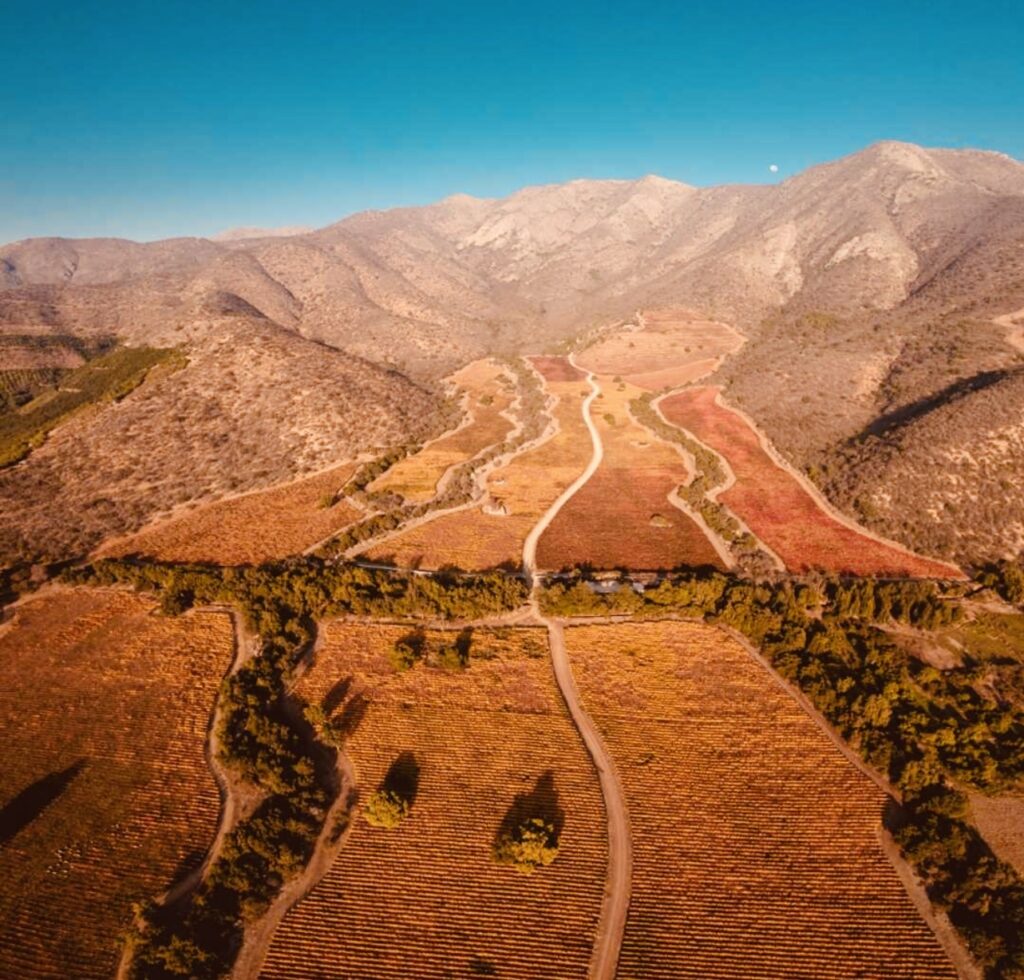
LG: Do you think climate change will change the character of the Aconcagua region long term?
FB: Mediterranean varieties perform very well in Aconcagua, it would be a shame to lose the identity of the valley, I think it will be a challenge for everyone in the future, it’s the same in Bordeaux. Some people are moving further south. – we have 4000 km – so they are moving further south where we have more rain and less heat but its difficult.
LG: is the main issue water supply?
Yes, I hope Maipu will hold but we do probably need more dams and reservoirs, more wells – its challenging for everyone. Bordeaux is the same and they can’t irrigate.
We have learnt a lot how to manage the hot vintages – irrigate more, expose the fruit less, encouraging more vigour etc but we need water that’s the main thing.
We have invested a lot in new wells – there is water down deep – you can find it but the wells are 100m deep and you have to get the water rights which is more challenging. When people move South to, for example Maule, there is not much water either, 500mm of rainfall a year. Maule is actually closed for new water supplies so you cannot make more wells.
We will see how it goes. It’s very tough. It takes ten years to assess the environmental impact of a new damn and we are very much behind.
Last year for Seña we made a well to secure water, the same for Aconcagua Costa but not everybody can do that. It costs a lot of money and for small producers it simply isn’t possible.
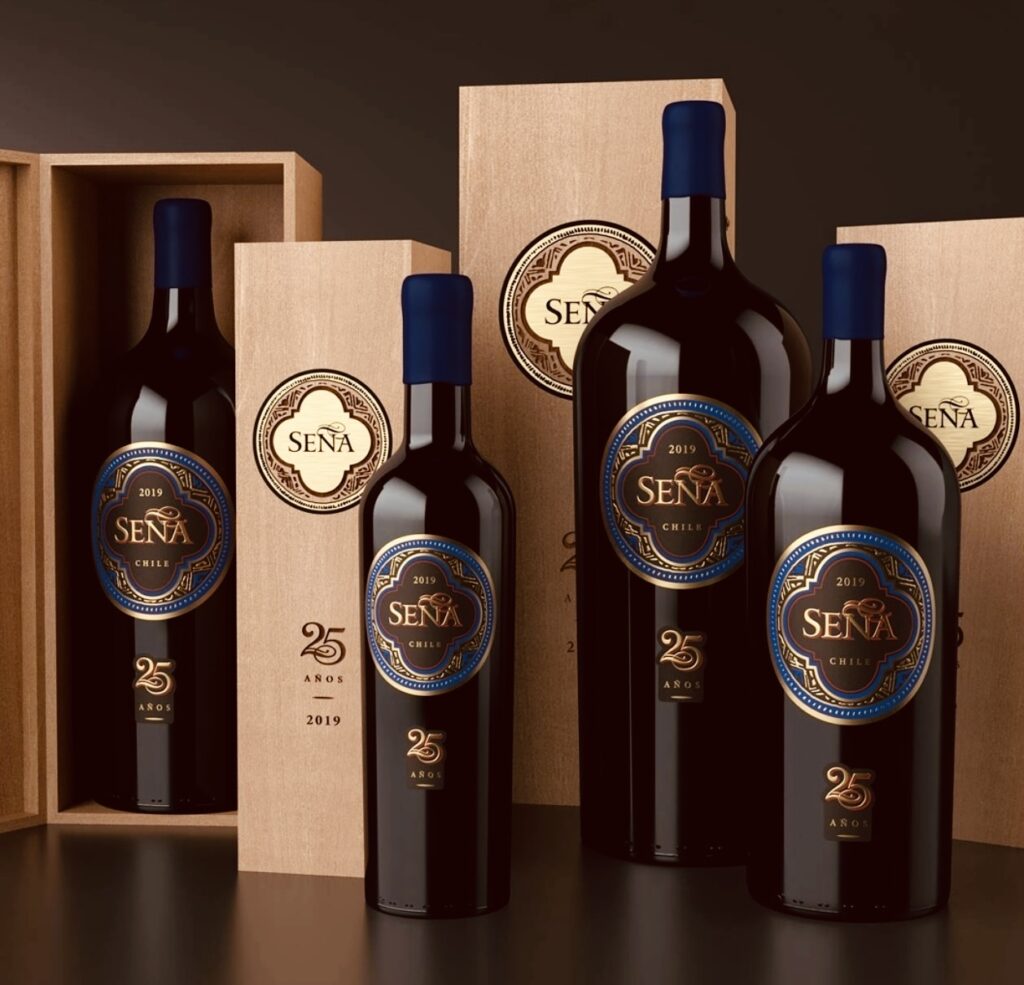
LG: Take us through the wines..
Seña style has been changing and it shows how we are new world because when Seña started in 95/96 the wine was 12.5% alcohol, more old world in style and we there was more ripeness, we were afraid of the herbal character. I remember having a lot of conversations about more balanced wines and lower alcohol, there was a lot of influence also from the market. I say style not quality because we can produce ripe, opulent, big wines in Chile but even with climate change we are also able to produce wines that are more restrained, in balance with the alcohol.
2009 was a hot vintage, it was dry and early, lots of concentration, the nose and evolution shows layers, its richer more opulent, and there is a sweeter finish. The tannins are round and supple but the finish has less tension and there is a riper, sweeter palate. We still have some Merlot in the blends, 100% new oak, Cabernet dominate. Carmenére depending on the vintage could play a big role as in this warm vintage. At this time we were very worried and a little obsessed about not having any hint of herbal character in the wine. I am not saying green or herbaceous. We used to say the best vintages were the odd numbers which were the hot vintages but today I prefer cooler vintages overall.
In 15 things are very different and the change is very apparent, change started in 2010, we were looking for a bit less new oak and a bit less alcohol and sugar, harvesting earlier and so you can see a big change. 15 was considered an excellent vintage as it was in Bordeaux in terms of concentration. At this time we had also made important changes in vineyard management and irrigation, picking earlier, protecting the fruit and we stretched the ageing from 18 months to 22. We started to use foudres from 2014. Malbec has started to play an important role here. I like it a lot, its completely the opposite to 16, more concentration but I find that the finish shows more tension, more vibrancy and acidity. The palate is less sweet in character. There is nice complexity and evolution but its still very lively and the layers are complex. Its more complex and layered – rather than just pure fruit. With time we changed the extraction, less pump over and less maceration, we sometimes remove the wines from the skins earlier than in the past so the skins are in better condition and not that extracted so the results from the press – the wines are made more like tea in terms of the production.
15 was the last very cold vintage – it was considered a difficult vintage as it was so cold, not for us, the alcohol was very low and we had huge rains in the middle O April, 100mm of rain which is very rare for Chile, up to 200mm in the South in two days and that opened the berries and we had big problems with rot and dilution for the concentration, some producers lost more than 50 % of the grape. In our cases we had picked almost everything but the Carmenére before the rain – that was ok because it has thicker skins. We knew the rains were coming but not as much as did come – I considered waiting but I decided to pick everything before rains, so I like this vintage – it’s the opposite of 15, its more ethereal elegant and complex and you can see the differences in the vintages. There is almost one-month difference in harvest date between the 15 and 17. 18 was a super polished and finished straight away 19, was excellent – good flowering etc but it wasn’t that hot in summer so the tannins are more present and firm and in my opinion its evolving very well in my opinion, I think it will age brilliantly. I think you can see the common thread from 15 onward where you find more juiciness in the wines and less of the sweetness and opulence overall.
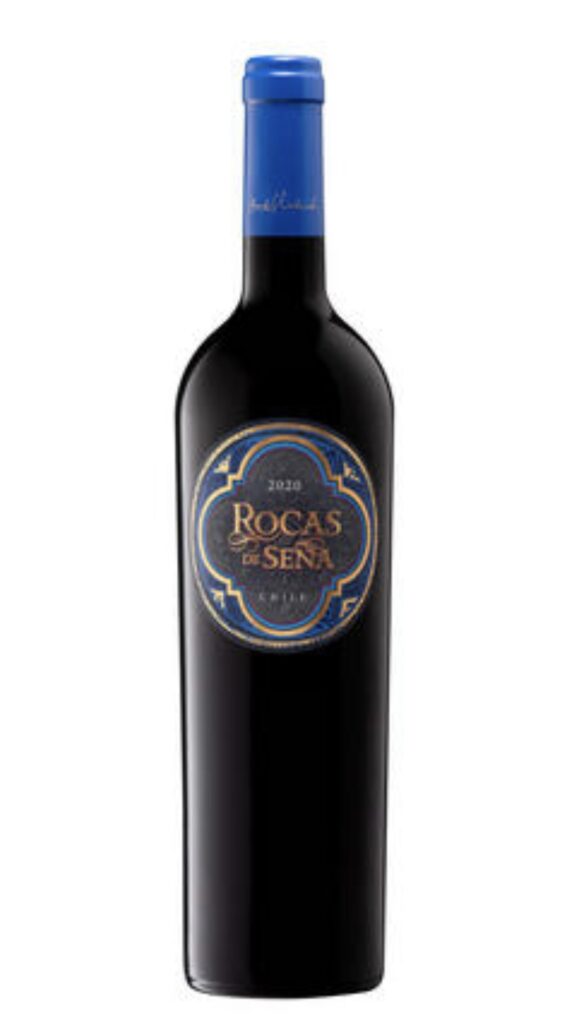
Rocas de Seña 2020 14% Alcohol. 38% Malbec, 25% (old vine) Syrah, 15% Cabernet Sauvignon, 14% (old vine) Grenache, 8% Petit Verdot £35.00
A move away from the classical Bordeaux Seña blend toward Mediterranean varieties that shouts diversity. Shows woodsmoke, ripe black cherry, iodine, cooling herb vapour, iron, blood and crunchy sour Asian plum. The fruit is noticeably ripe but the palate is mouth-wateringly fresh – the tannins are grippy and firm but fine and the finish long, dry and savoury. 93
Seña 2009 14.5% Alcohol. 54% Cabernet Sauvignon, 21% Carmenére, 12% Malbec, 7% Petit Verdot, 3% Cabernet Franc RRP. £143.50
The first wine to score 90 points on release, this true classic is deeply impervious in colour and shows a brick red rim. Savoury woodsmoke, graphite, iodine, Asian plum and sumptuously rich dark chocolate layers prove endlessly seductive. The texture is sublimely silky; a bolt of gossamer satin, weighty yet gorgeously fleeting, the tannins smooth. Elegant and fresh, sour and juicy, with a deep dark chocolatey core. Ripe red cherry and spiced black plums conspire with tepid tobacco; just rolled cigars moistened by fleshy fingers. Effortlessly fine. Rich and opulent with a sensually sweet and easy finish. This wine brooks no challenge – for it is universally understood and endlessly charming 96
Seña 2015 13.5% Alcohol. 57% Cabernet Sauvignon, 21% Carmenére, 12% Malbec, 7% Petit Verdot, 3% Cabernet Franc RRP. £150.00
This wine is silky, savoury, firm and concentrated; super complex, textural and vibrant; taught with tension and seductively fine tannins. Hung pheasant, liquorice, incense, iodine, dried black olive and blood; deep plum, sour cherry, blueberry and civet. The finish is endless – Moreish, chewy and savoury 97
Seña 2016 13.5% Alcohol. 55% Cabernet Sauvignon, 20% Malbec, 12% Petit Verdot, 8% Carmenére, 5% Cabernet Franc RRP. £126.00
This wine is super smoky – savoury and dense on the nose with Asian plum, wild English blackberries, incense and rain dampened woodsmoke. The tannins are velvety; the texture, sublime and silky. The finish is lengthy and laced with sour plum. It is bright, puckered and elegant, very different to 2009; more structured, more savoury, more restrained and infinitely more modish! 94
Seña 2019 13.5% Alcohol. 60% Cabernet Sauvignon, 21% Malbec, 15% Carmenére, 4% Petit Verdot, RRP. £130.27
This wine is refined, structured, elegant, taut and fresh. Notes of woodsmoke wend their way through a light dusting of dark chocolate powder, pencil shavings, coffee, puckered red fruit and blackcurrant leaf. The texture is sublimely silky, the tannins, chewy and present – firm and fine. There is less opulence, more restraint – the wine is mouth wateringly fresh, sapid, long and refined. Such an elegant acid line and so much more to show us in time I feel… 95
Seña 2020 13.5% Alcohol. 53% Cabernet Sauvignon, 25% Malbec, 15% Carmenére, 7% Petit Verdot, RRP TBC
Fragrant with floral incense, juicy with crunchy sour cherry and round black fruit; this harmonious vintage offers firm fine-grained tannins, savoury tobacco, Asian plum, black cherries and spice. There is a subtle green herbal note that is deliciously moreish and it has so much more to show 95
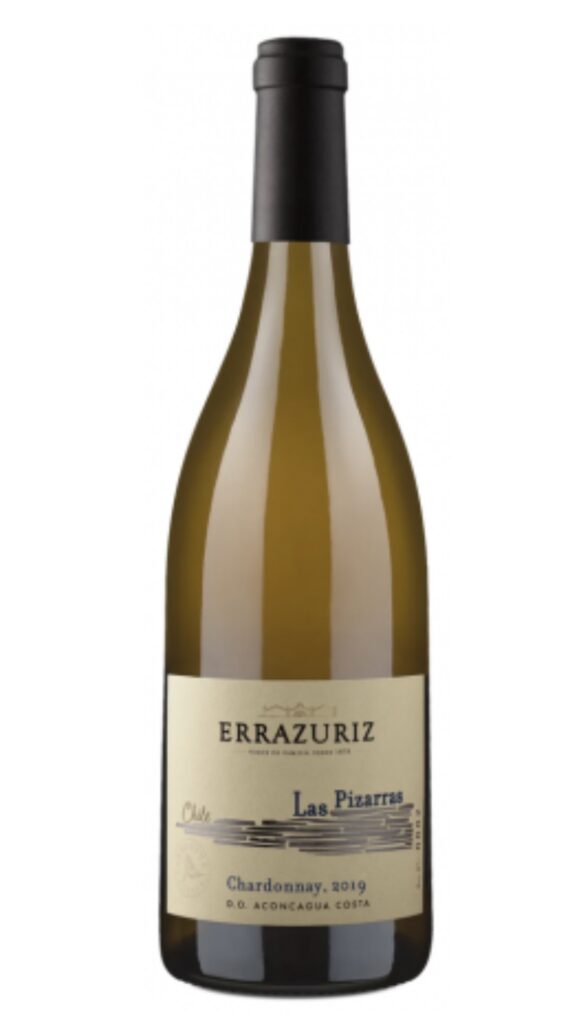
Las Pizarras Chardonnay 2020 12.5% Alcohol. RRP TBC
Beautifully elegant, taut and fresh with imagined minerals, candied lemon peel, zesty lime, white blossom and golden apple plus a touch of ripe grapefruit. Tastefully oaked and moreish tasty; this wine is grown on slate and shows a strong Pacific influence. The finish has a subtle hint of spiced brioche. Delicious. 96
Las Pizarras Pinot Noir 2017 13 % Alcohol. RRP £55.00
Clean fresh, brightly structured and precise, this wine is fruit forward with notes of wild strawberry, morello cherry jam, tart cranberry, black cherry compote and plum – a bats squeak of florality and a hint of mineral notes too. A deliciously fresh backbone of acidity and a structured delicately spiced tannic element. Cool, fresh and tense with a gently tannic finish 93
Las Pizarras Pinot Noir 2020 13 % Alcohol. RRP TBC
Beautifully floral, a delicate hint of dried rose petal and spice on the nose and palate; black cherry, strawberry and just a touch of earthy wet woodland soil. Tannin is fine and chalky, overall the sensation is of languid silk. A structured acid backbone delivers freshness and tension. The finish is long, dry and savoury 92
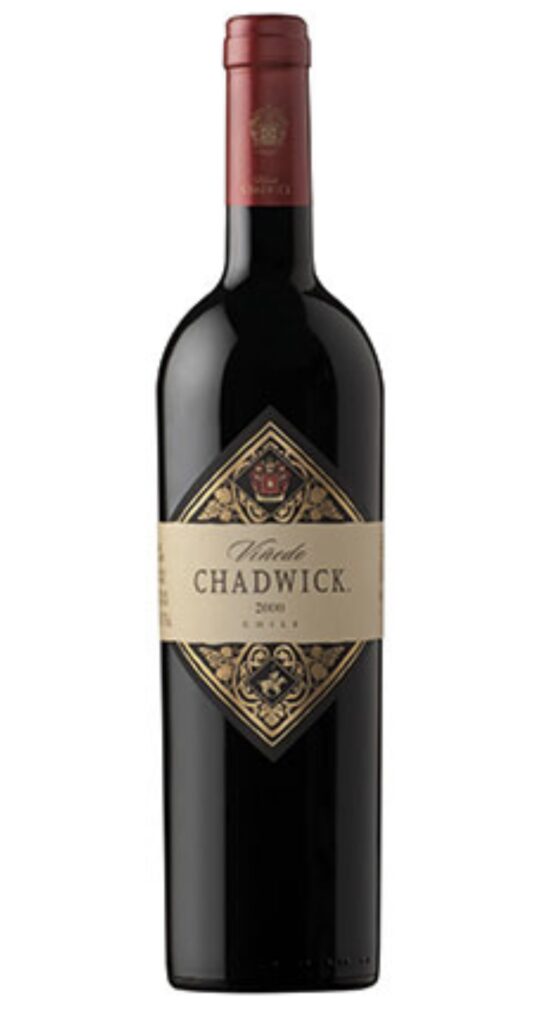
Viñedo Chadwick 2014 13.5% Alcohol 100% Cabernet Sauvignon
Luscious, layered and complex, this sublime wine delivers languid levels of dark spiced plum, sour cherry, liquorice, dried rose petals and graphite dusted with dark chocolate. Gorgeous and lithe, with supple tannins and a cooling freshness that invigorates the palate and draws it ever onwards – questing for more mouth wateringly elegant succour before finding satisfaction in a lengthy finish 97
Viñedo Chadwick 2015 13.5% Alcohol 100% Cabernet Sauvignon
Harmonious and complete, super silky, bright and lithe. This offers fresh spiced cocoa notes, sour cherry, moist tobacco, a cooling herbal element and pepper. Dense and round yet sinewy and fresh. 96
Viñedo Chadwick 2016 13% Alcohol 97% Cabernet Sauvignon 3% Petit Verdot
Ripe plum, blackcurrant, stinging nettles, graphite and woodsmoke – gorgeously savoury and dry on the finish. The mouth is weighty with silk and textured with superfine tannins. 95
Viñedo Chadwick 2019 13% Alcohol 97% Cabernet Sauvignon 3% Petit Verdot
Delectable dark deep plum, raspberries, cherry and moistened woodsmoke tinged with graphite. Super-long layered and persistent – laced with the finest tannins known to humanity. Moreishly sour, fresh, sapid, superb. Precociously elegant 95
Viñedo Chadwick 2019 13% Alcohol 100% Cabernet Sauvignon
Opulent, dark-fruited and sweet scented, this spiced, dark chocolate scented siren shows density, freshness and delectably fine chalky tannins 96
